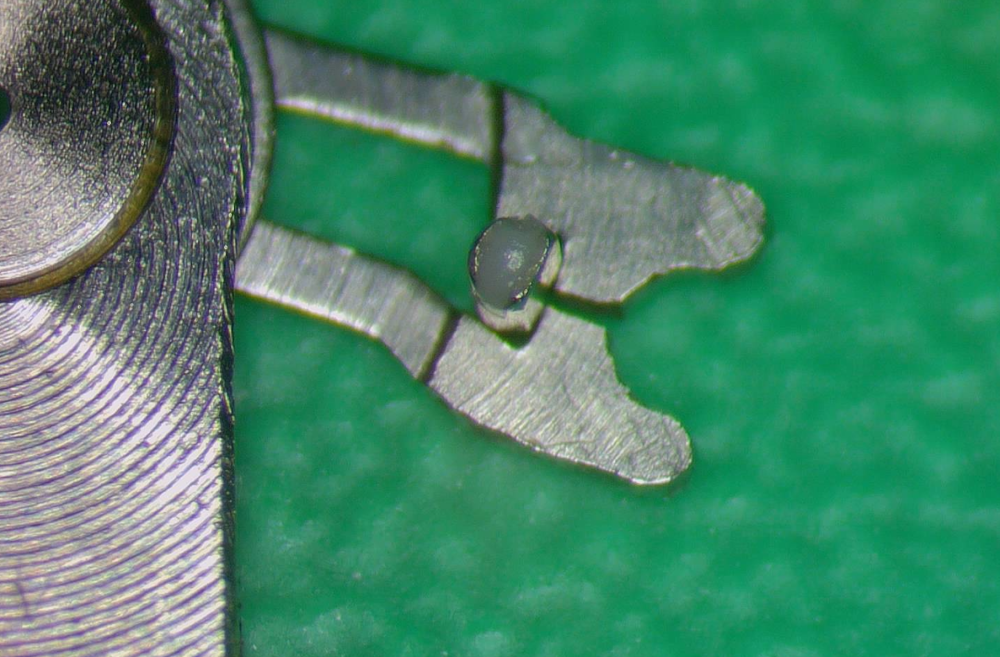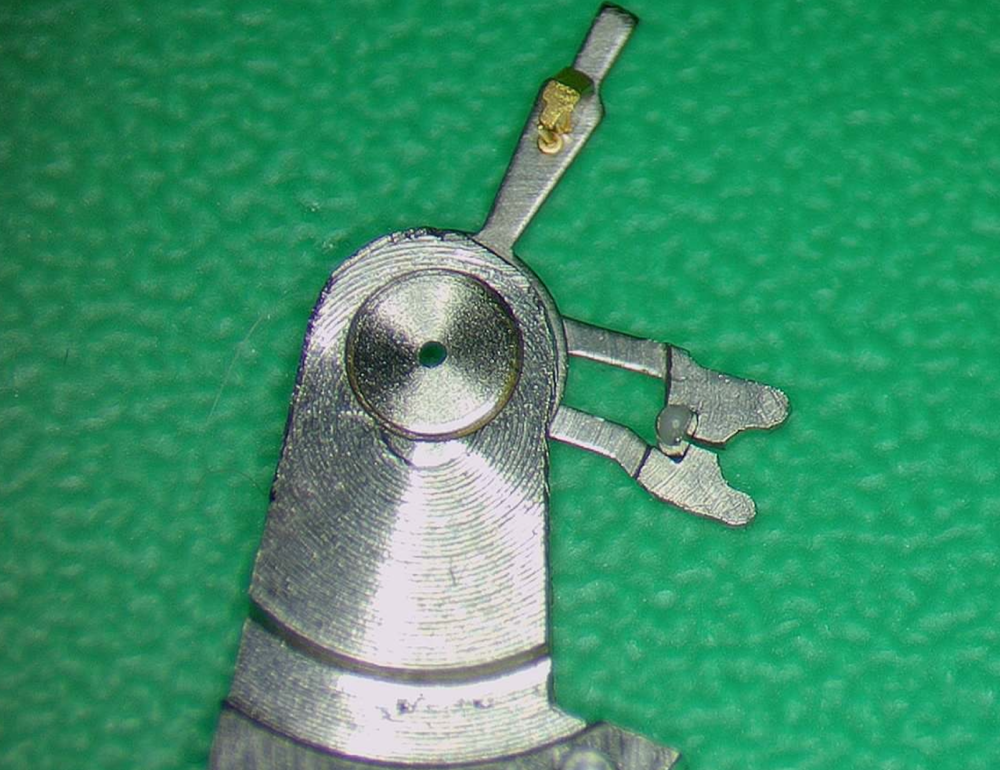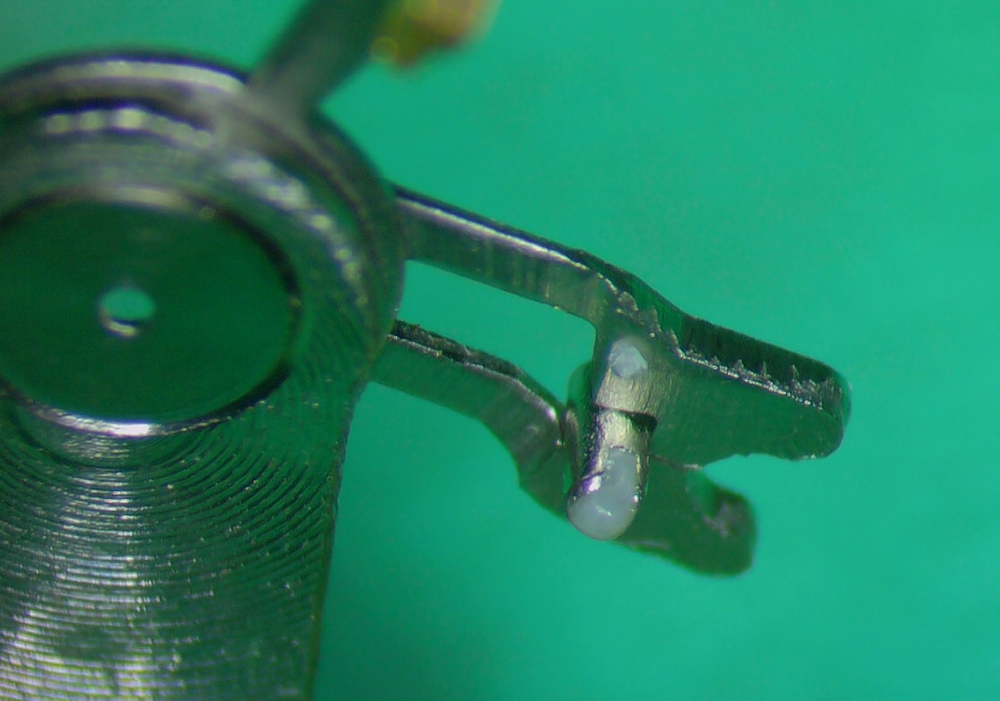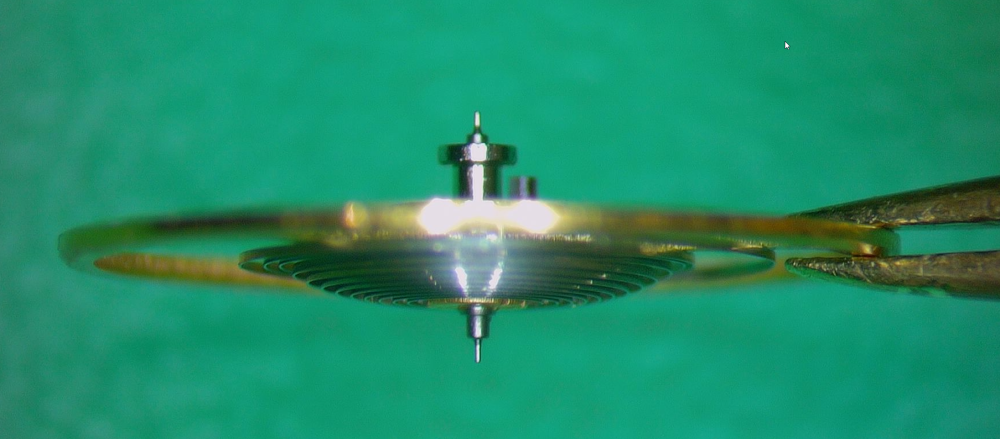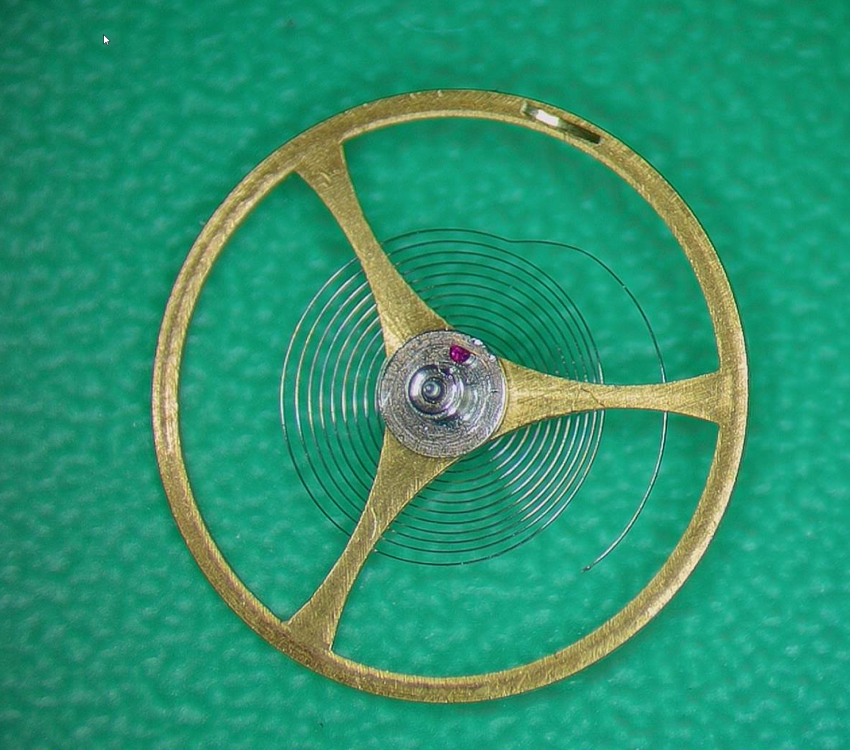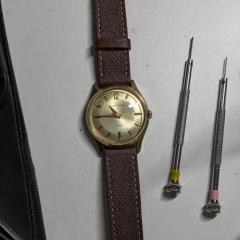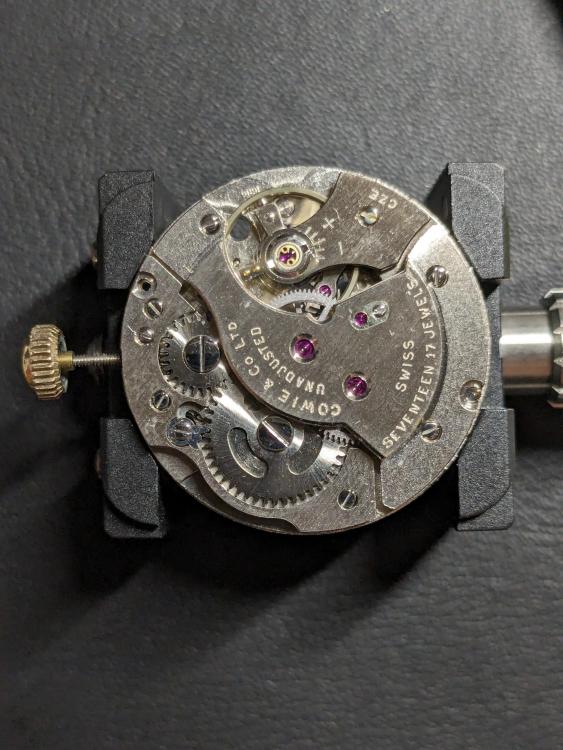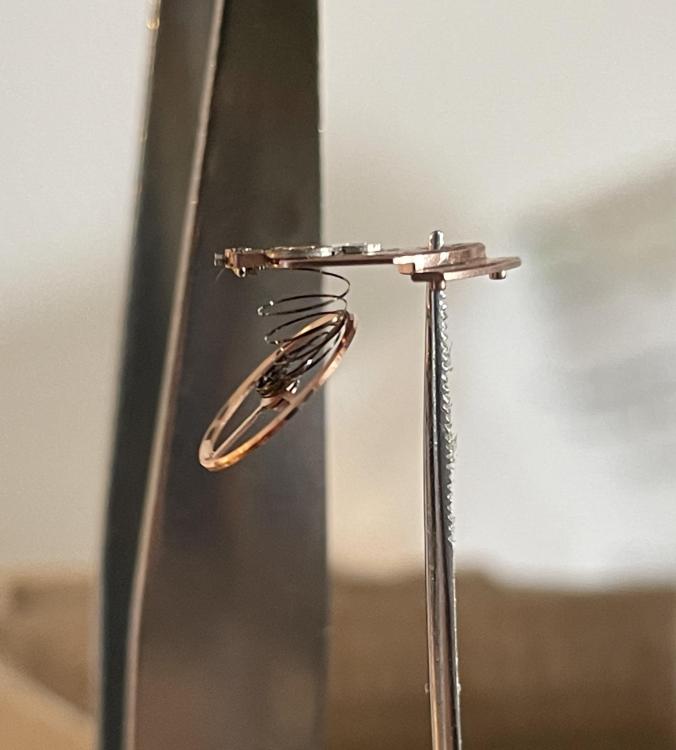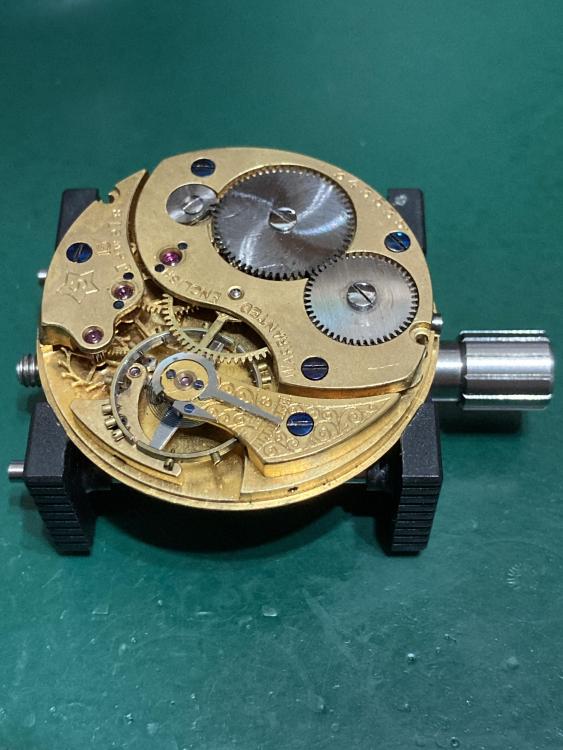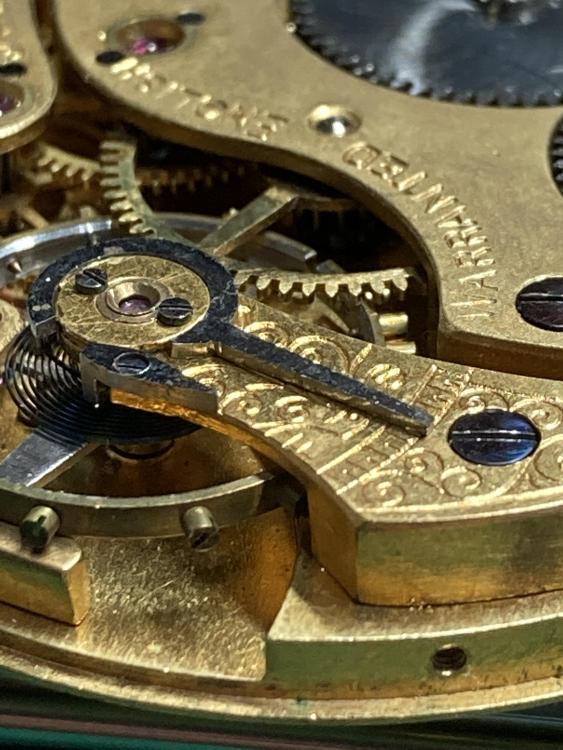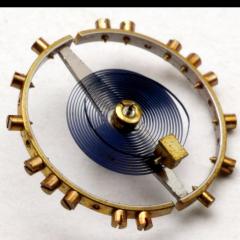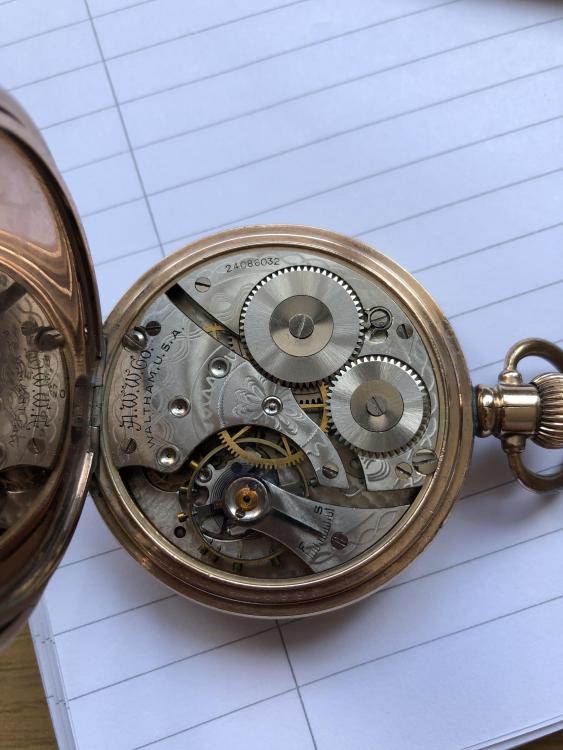Search the Community
Showing results for tags 'balance'.
-
Hi All, I'm relatively new to watchmaking. Having serviced a few watches already, but I so far dodged more involved repairs. I was working on a nice Vostok watch. I have disassembled, cleaned, reassembled and lubricated the movement. One of the last steps were to reseat the balance complete. The balance didn't want to move freely so I had to take out and put it back a few times. I could have been too hard with the part or maybe the hairspring wasn't connected well enough. All in all, the hairspring got disconnected from the balance cock. My main problem now is that I don't recognize the substance/adhesive that the hairspring was connected with originally. It's a relatively tidy job so I think it was done in the factory but it's not shellac. I don't know if this can be warmed up so I can offer back the hairspring or should it be removed and replaced with an equivalent adhesive substance. The hairspring is OK as far as I can tell. Please kindly help me formulate a repair plan for this part. I would like to repair this part myself. I can easily source a replacement balance complete but I would like to learn how to deal with this. And now the pictures.
- 3 replies
-
- vostok 2409
- balance
-
(and 3 more)
Tagged with:
-
Hi, I wanted to ask around here before attempting to lubricate the shock setting on this watch. It's got an odd assembly that I wasn't able to find online and I'm unsure of how to take it apart. This comes from an FHF 1686 movement. Any help with identifying this shock setting and subsequent disassembly help would be appreciated!
- 12 replies
-
- shock-spring
- incabloc
-
(and 3 more)
Tagged with:
-
Hello everyone, I bought an omega with an 711 movement and managed to find the problem : the hairspring was twisted. So I bought another balance and while trying to fit it in the movement I pushed a bit too hard on the tweezers and it made a 180 Flip (upside down). This tiny little accident made a “knot” in the hairspring, does anyone know if there is a way to fix it ? Thank you very much and sorry for my frenglish Louis
- 20 replies
-
Hello, I am attempting to service an old H. Williamson pocket watch movement and hit an obstacle before I even started. I know I'll need to disassemble the balance in order to oil the non-shock end stone but having watched one of Mark's newer videos advising on the danger of removing the end stone mounting screws while the balance cock is mounted, I'm wary of doing this. However, with the Breguet hairspring held to the cock with with its own screw-retained "carrier cock" (holding the pinned hairspring) instead of a stud carrier, also top-mounted, I don't know what's riskier? As you can see, this old 1918 movement is a work of art in itself and I'd hate to mess it up. My concern is also how I'd manage to reassemble the hairspring to the balance cock safely after servicing. Do any of you know the safest "best practice" for disassembling and re-assembling such a balance please? Thanks, Adam
-
Good day to you all. I'm deciding to ask for help because I really can't manage it by myself. For the life of me I cannot understand how to set the balance assembly back into position after having replaced a broken escape wheel. I'm working on a Lanco/Tissot 782-1 movement, I had already removed/replaced the balance before and I haven't had any issue. Now I just can't seem to get the balance oscillation working. The wheel seems to stick or isn't turning freely. I have spare parts and checked 2 or 3 different balances, I checked the staff & its pivot which are not broken, the roller jewel isn't broken either, the balance pivot hole is not clogged nor does it seem widened, and the pallet is in working order (I checked the escapement by arming the mainspring a couple of clicks then manually oscillating the pallet with a wood pick, everything runs perfectly). So it seems the rest of the movement is okay, the issue lies with how to place the balance back into position. I checked lots of tutorials & videos, Mark's included and I'm always quite astonished when I see how watchmakers and repairmen handle the balance, even if the hairspring is fragile even professionals seem to handle that part somewhat roughly. I take the greatest care when manipulating that part (and others) but no matter how I set the wheel&pivot back, the movement doesn't seem to run. Is there something I'm missing? Should the pallet be positioned specifically when replacing the balance? Should the roller jewel be placed in a specific setting versus the pallet fork as well? Everytime I tried before those things didn't seem to make a difference, so I'm really wondering what's wrong here, considering I tried several balances with different plates and different pallets, I can't understand where the issue is. I guess my question is: as tutorials don't usually give out many details about how to lay a balance back down into the plate, what should I take into account and what are the exact right steps to perform to ensure the balance will run smoothly ? Thanks for your help, I'm getting desperate here :-/ Laurent AKA HardTop
-
hi everyone, today I was working on a watch (the movement was eb8810) and after I was happy with the result I put the movement under a. glass, come back to it 2-3 hours later, still ticking so I put it back in the watch case and after about 15 seconds it stoped ticking as I started to move it around I don't know where to go from here wether or not it needs re-oiling or a new part in the balance operation, this is not the first watch I have experienced this in and didn't end up doing anything with the other watch. thanks in advance, Ali p.s I am looking for an eb8800 movement in working condition so message me if you have one
- 2 replies
-
- watch repairs
- repairs
-
(and 3 more)
Tagged with:
-
Hi everyone, was super delighted to see how responsive this community is... I am resolving the 1st issue with my Slava watch and now I am confident I can get some help with my Molnya 3602 -I took it apart and noticed the balance spring is a little uneven and does not go back and forth... I took the bridge off (one screw) took out the balance wheel and spring attached but did not see anything wrong, out it back and the same issue pessimists. I need help understanding if the balance wheel is properly installed and / or needs replacement to get the mechanism to function. checked all other parts and main spring is good. Would help if I can also find the front crystal/glass and an authentic face.
-
I hope this is the right place to post this question? But how does this even work ..is it just there for show? it's hard to tell from the photo's but looks like there is no escape wheel on the right balance but there is one under the left balance? http://www.good-stuffs.com/Shanghai-Diamond-double-skeleton-flying-wheels-automatic-watch_p_296.html
-
All, Some of you will know that I have been working recently on a vintage movement. It's an Omega Ca. 266. from 1954 according to the seller - presumably based on the serial # from the movement. I decided to give the movement a full service - as I didn't know the service history. Which after stripping down the watch, it was apparent that it had been serviced in recent history. As everything was incredibly clean and all lubricants still clean and fluid. Of course, I wouldn't have know that without stripping it down. After reassembly (following cleaning and fresh lube) - most everything seems to be in good order. But I can hear a funny (odd) "ting" noise in the heartbeat when the movement is positioned such that the balance staff isn't vertical (isn't dial up or dial down). I assume that the noise is coming from something in the balance. But I don't see anything too weird on the timegrapher. Other than too much beat error (1.2 - 1.8 ms depending on position). So, two questions (I am assuming this isn't normal or healthy) 1) What would you check for? 2) How does one correct (or improve) the beat error on a balance without a beat correction? I am guessing that the hair-spring would need to be loosened at the stud. Then position the balance to the center position and tighten the hair-spring stud? Or something like that. I am seeing about 250 degrees amplitude dial up or down. -4 sec/day. Down to about 210 degrees with the balance staff horizontal. Not much variation in the timing. Worst position was -9 secs. Most about -4. Best +1. If I hadn't put the movement up to my ear, I wouldn't have any idea that something was "off". -Paul
-
Question for those who work on Vintage Timex watches: I've restored several Timex pieces from the late '60s to the late '70s. The technique I learned (from Internet posts and tutorials) say to simply loosen the dial-side balance pivot by unscrewing it 1/2 turn prior to cleaning the entire movement in an ultrasonic cleaner. This method contradicts the official Timex service manuals, which state that the balance should be removed, cleaned separately and reinstalled. Thus preventing the hairspring form being damaged in the ultrasonic cleaner. My experience is this: Leaving the balance in place (slightly loosened) is much easier and will work on the standard movements used in the '70s (M24/25, M32/33, M104, etc.) Attempting the same method on movements from the '50s and '60s (M22, M29, etc) will result in a kinked hairspring that is damn near impossible to un-kink. So my question is this: What do you experienced Timex restoration experts recommend? Leave the balance/hairspring in the movement for cleaning, or take it out to soak in a separate jar? Is the potential for hairspring damage greater when removing/reinstalling the balance - in comparison to leaving it in place? I've messed up a couple of vintage movements that I really wish I hadn't. I don't want to make those mistakes again. Thanks for any insights! -Todd
-
Hi, I am very new to the hobby of watch repair/refurbishment and self taught thus far so please forgive any stupid questions! I recently stripped down, cleaned, oiled and reassembled a Waltham pocket watch (pictured) but the balance has poor oscillation, stops when tilted at a certain angle and the movement makes a noise in addition to the usual tick which sounds like something is hitting off something it shouldn't. I've stripped the movement down again and checked every part for signs of damage (finding none) and also replaced the mainspring which has improved things but there's still something off. Any ideas on what it might be would be much appreciated.
- 21 replies
-
- pocket watch
- waltham
-
(and 1 more)
Tagged with:
-
Hello, I have a watch with a screw down crown and hacking feature.The watch is NOS about 5 years old and it is an automatic watch and I've noticed when I unscrew the crown, change the time, and screw it back the balance wheel/balance spring stops and starts, doesn't move or moves very slowly. When I move it about a bit it starts moving slowly for a while then stops, when I tilt it it moves but slowly. At first I thought there must have been dust within the movement, but when I unscrewed the crown and fiddled with it a bit, pulled it all the way out to change the hands and pushed it back in and screwed it back the balance wheel works as normal, whether I move it about or not it moves as it should. Is there something wrong with the watch? is it time for a service? Is this a serious issue? Should I stop using the watch until it is fixed? Thanks for reading and I hope someone could answer, sorry if it's all jumbled up I'm not sure how to explain it.
-
Can someone tell me the correct tool to use to restaff a balance wheel on a vintage pocket watch. Should I do it right on the staffing tool anvil or should I use a stump. What would be the best way without bending the balance wheel? Thanks
-
Hello, can anyone tell me why my balance wheel hole is bigger than the staff replacement that is for that balance. I was trying to fit it with a staffing tool but could not get it to make a rivet on the wheel.
-
First, thank you all for your help. I’ve been reading several posts that have helped me since I first joined several weeks ago. I’ve been very fortunately the last year or so learning watch repair as a hobby. It’s been very rewarding and fun (as all of you know :P) A few months ago, I drunk bid, and won, this Zodiac Seawolf on eBay. It was supposedly running and then stopping after a short while (which was true). However, during disassembly I found it was missing the case tabs, hacking/stop lever, and most of the date mechanism parts. I was able to get it appart, cleaned, and luckily with a donor Aerospace GMT for the date parts, was able to get it back together and running. I put the balance in and the hairspring adjusted, I put the automatic winding mechanism on and the watch went completely out of adjustment. After removing the auto winding mechanism, I noticed that the hairspring was touching itself. So I removed the balance, made sure the hairspring was back in position, reinstalled it adjusted it, and after putting the auto parts back on it was running ok. Then I cased it, and again it went completely out of adjustment. I’ve been through this exercise several times now, and even tried with the balance from the Aerospace GMT donor I have with the same results. The last time, I tried to check that the rotor wasn’t hitting the balance, and it doesn’t appear that it is (at least I can’t see where it would be). I’ve demagnitized the movement and case several times too. I’m still missing the stop lever and one of the case tabs, but I wouldn’t think either of those would cause this kind of havoic on the balance. Does anyone have any guidance on what to look for which might be causing my balance(s) to go wonky? Below are pics. Original balance in: Everything looks ok and adjusted (not great but ok): Auto on: Everything still looks ok: Just about to case it and then decided to check one more time and hairspring look ok from what I can see. WOW Look at that shotgun scatter pattern: And it’s wonky again :pulling-hair-out:
- 15 replies
-
- balance
- hairspring
-
(and 2 more)
Tagged with:
-
Hi I'm kinda new to the whole "watchmaking scene". I started off with taking apart a tissot and a seiko. I seem to stumble upon the same problem everytime: When I reassemble the balance wheel onto the main plate, it seems to run slower. Also it tends to stop when it's held sideways (sometimes even when it's flat). (I tried to upload a video, but apparently I don't have permission to do so) I also tried to search this forum but haven't found anything similar. Can anyone help me with this one please? Great forum, I already learned a lot here! Thanks in advance

